Alioth, also known as Epsilon Ursae Majoris, is the brightest star in the constellation of Ursa Major, and the brightest of the seven stars of the Big Dipper. It also shares the 31st place as the brightest star in the night sky with Alnitak.
Key Facts & Summary
- Alioth is classified as A1IIIV-IVp Kb9 – meaning it is a white or blue-white, giant of subgiant star with a peculiar spectrum. kB9 – means that there are calcium K lines in its spectrum.
- Alioth is located at 82.6 light-years / 25.3 parsecs away from our sun in the constellation of Ursa Major.
- The star’s apparent magnitude is 1.77 while its absolute magnitude is -0.2.
- Alioth is also an Alpha2 Canum Venaticorum variable star. These stars are chemically peculiar, still on the main sequence and have strong magnetic fields and strontium, silicon or chromium spectral lines. These spectral lines along with the magnetic fields vary, and so does its brightness – the periods of their variations are theorized to correspond to their rotational orbit.
- Alioth is more massive than our sun, having around 2.91 solar masses.
- The star’s radius is 4.14 times that of our Sun. It is also much hotter than our sun, with average surface temperatures estimated to be around 9.020 K.
- Alioth is around 102 times brighter than our sun, yet the star is younger, having an estimated 300 million years.
- Alioth has a rotational velocity of around 33 kilometers / 20.5 miles per second.
- Alioth’s magnetic field is 15 times weaker than α Canum Venaticorum, but it is still 100 times stronger than that of Earth.
- The gravity on Alioth’s surface has been estimated to be around 3.23 cgs.
- Alioth has been used throughout history as a star for celestial navigation in the maritime trade.
Though it is the brightest star in its constellation, Alioth, for reasons unrelated to its brightness, isn’t designated as the Alpha star of its constellation. The second brightest star in this constellation, Dubhe, is around 2% dimmer than Alioth.
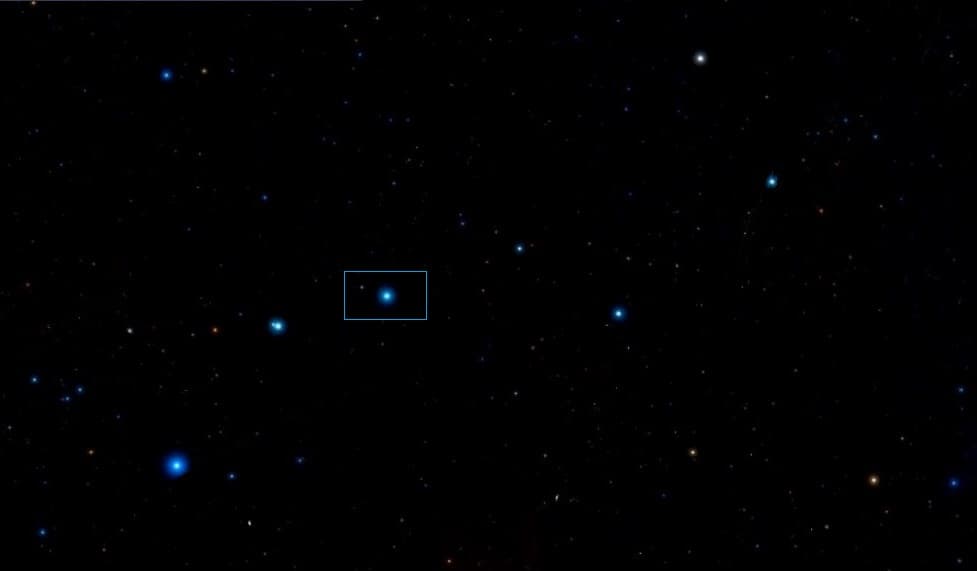
Alioth’s name is of Arabic origin, it is derived from the Arabic word “alya”, which translates to “fat tail of the sheep” while other sources claim that this is a mistake, and the original translation refers to a black horse.
Formation
Alioth formed around 300 million years ago from a molecular cloud of gas and dust. The gravity pulled the swirling gas and dust together to form the brightest star of the Ursa Major constellation. Alioth is also a member of the Ursa Major Moving Group of Stars, it is a large diffuse group of stars that share a common origin, and a large common motion across the sky.
Distance, Size, and Mass
Alioth is located at around 82.6 light-years / 25.3 parsecs away from our Sun. This star is almost three times more massive than our sun, with an estimated 2.91 solar masses.
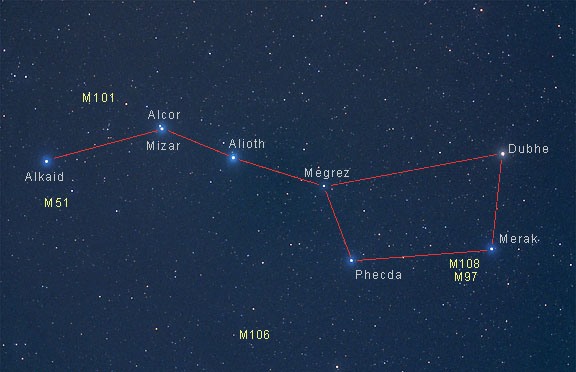
Alioth has a radius of around 4.14 times that of our sun, its diameter is suspected to be at least 8 times bigger. This means that the star should also be around 8 times bigger than our sun.
Other Characteristics
Alioth is classified as A1IIIV-IVp Kb9 – meaning it is a white or blue-white, giant of subgiant star with a peculiar spectrum. kB9 – means that there are calcium K lines in its spectrum. The star’s apparent magnitude is 1.77 while its absolute magnitude is -0.2.
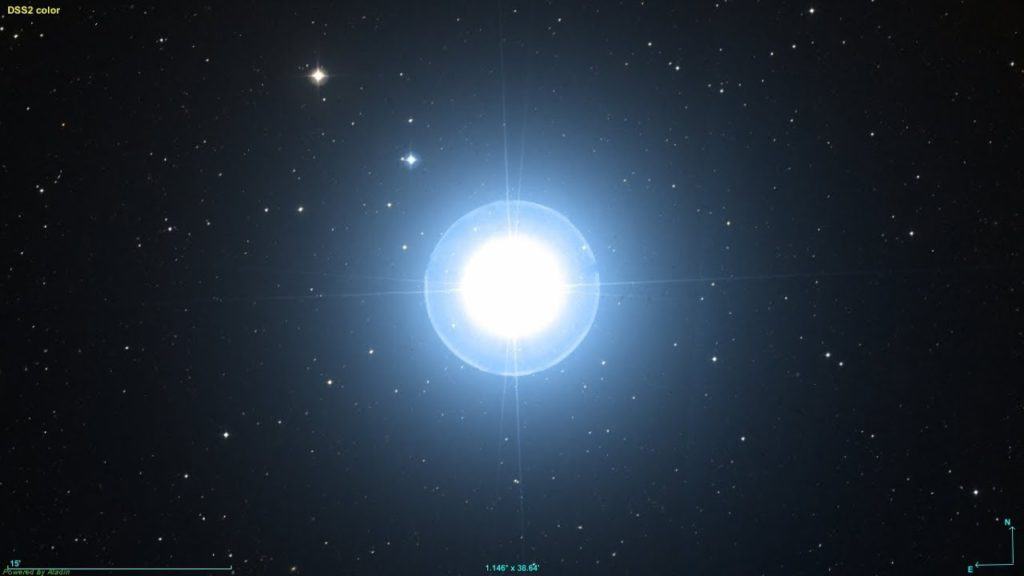
It is a variable star of type Alpha2 Canum Venaticorum. These stars are chemically peculiar, still on the main sequence and have strong magnetic fields and strontium, silicon or chromium spectral lines. These spectral lines along with the magnetic fields vary, and so does its brightness – the periods of their variations are theorized to correspond to their rotational orbit.
This means that Alioth is actually the brightest peculiar class A star in the night sky. Its magnetic field separates different elements in the star’s hydrogen supply and thus its axis of rotation is positioned at an angle to its magnetic axis and it is believed that it is spinning different elements into different regions that come in and out of sight as it rotates.
As the elements spin, they react differently and as a result, the star’s spectral lines are fluctuating during its rotation period. Alioth’s rotational and magnetic poles are positioned at around 90-degrees angle to one another.
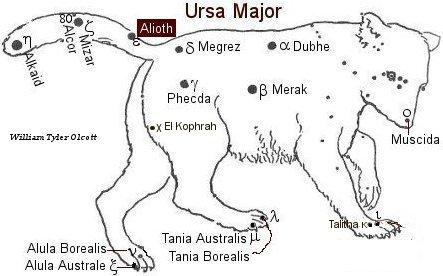
Thus, the abundance of oxygen is around 100.000 times greater around the magnetic equator than near the magnetic poles and chromium is more densely concentrated as a consequence, in a band positioned at a right angle to the equator. In comparison to other variable stars, Alioth’s magnetic field is weak. However, it is still 100 times stronger than Earth’s magnetic field. Alioth has a rotation period of 5.1 days and both its magnetic field and brightness change during this period. Alioth is around 1.5 times hotter than our sun, with average surface temperatures estimated to be around 9.020 K. When it comes to its brightness/energy output – Alioth is 102 times brighter than our sun.
Location
Alioth is located in the constellation of Ursa Major, near the bear’s celestial tail rear end. Ursa Major is the largest northern constellation and the third largest out of the 88 constellations.
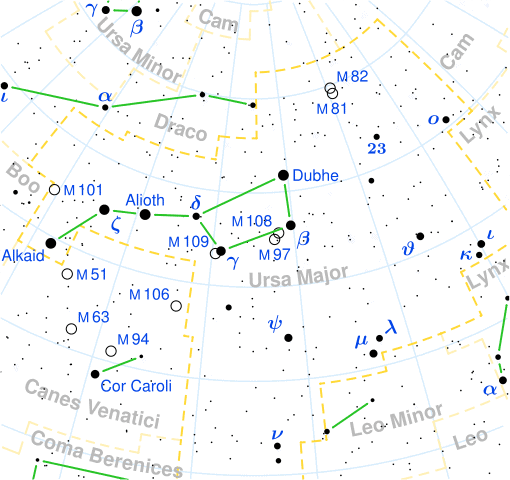
Alioth is also part of the Big Dipper asterism. It is the third star of the asterism’s handle, closest to the bowl, and much brighter than most of its neighbors. The star lies in an area of the sky where the spiral galaxy Messier 106 is located, and also the Pinwheel Galaxy.
The stars of the Big Dipper asterism are circumpolar to most northern locations and thus they can be seen throughout the year. One of the best months to observe them is during April.
The Future
Alioth appears to be a stable star and will remain so for many years to come. Its chemically peculiar spectrum and its title as the brightest star in its constellation will keep this star in our attention for a long time.
Did you know?
- Alioth, along with Dubhe, and Alkaid are among the 58 navigational stars selected for celestial navigation. Only the brightest and the most easily recognizable stars are part of this group.
- For the Chinese, Alioth was known as the Fifth Star of Northern Dipper which is the same as the Big Dipper asterism.
- In the Hindu language, Alitoh was known as Angiras, after a Vedic sage. He was considered a teacher of divine knowledge and a mediator between gods and men. He was also known as one of the first fire gods, or Agni-devas.
Sources:
Image source:
- https://www.star-facts.com/wp-content/uploads/2019/09/Alioth.jpg
- http://www.astronomytrek.com/wp-content/uploads/2017/07/Alioth.jpeg
- https://i.ytimg.com/vi/H-2U8hmxw7I/maxresdefault.jpg
- https://www.constellationsofwords.com/images/stars/Alioth.JPG
- https://upload.wikimedia.org/wikipedia/commons/thumb/e/e3/Ursa_Major_constellation_map.svg/510px-Ursa_Major_constellation_map.svg.png
